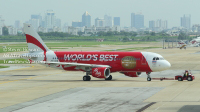It hasn't formally announced its intended network but in what it sent the Directorate General of Civil Aviation, it says the main hub will be Chennai. And, listed 10 line stations, destinations where an airline does pre-flight departure checks, transit checks and routine maintenance of aircraft.
In AirAsia's statement of intent, put up on the DGCA website, it listed Bangalore, Trichy, Madurai, Coimbatore, Cochin, Goa Hyderabad, Ahmedabad, Jaipur and Pune as line stations. This might not be the final list; it can introduce flights to only some of the cities in the initial phase and can amend the list. A check of existing flight schedules from airline websites and the DGCA site shows multiple flights between Chennai and the 10 cities. The exception is Jaipur, connected to Chennai via Ahmedabad by a sole IndiGo flight.
"There is a potential to start additional services on Chennai-Ahmedabad and Chennai-Pune, especially for business traffic. We believe AirAsia could also utilise aircraft on certain routes on a seasonal basis. Goa flights are in demand in winter, so it could add a flight for only that season. We feel a part of the AirAsia strategy could be to launch international services from regional cities such as Coimbatore and Madurai, which do not have foreign connections," said an executive from a rival airline.
===========================
EXISTING DAILY DIRECT FLIGHTS
Does not include flights which operate on certain days of week or with one stop
- CHENNAI-BANGALORE
12 flights - CHENNAI-KOCHI
6 flights - CHENNAI-COIMBATORE
7 flights - CHENNAI-GOA
2 flights - CHENNAI-HYDERABAD
12 flights
CHENNAI-JAIPUR No direct flight. One flight via Ahmedabad - CHENNAI-AHMEDABAD
2 flights - CHENNAI-PUNE
4 flights - CHENNAI-TRICHY
4 flights - CHENNAI-MADURAI
8 flights


